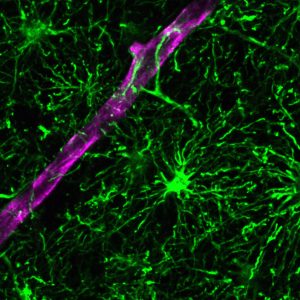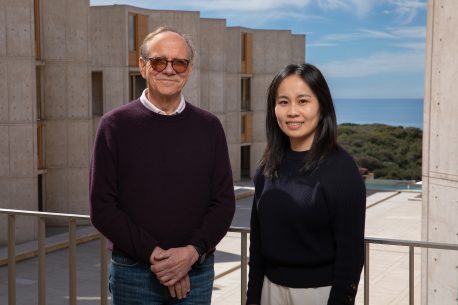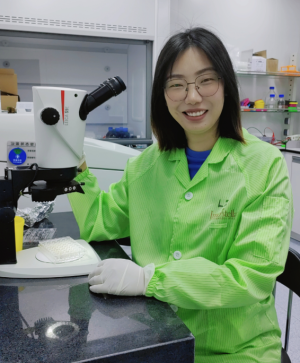
February 28, 2024
Salk scientists create human brain organoid model with abundant astrocytes to study stress and inflammation in neurological diseases like Alzheimer’s
Salk scientists create human brain organoid model with abundant astrocytes to study stress and inflammation in neurological diseases like Alzheimer’s
LA JOLLA—The brain is typically depicted as a complex web of neurons sending and receiving messages. But neurons only make up half of the human brain. The other half—roughly 85 billion cells—are non-neuronal cells called glia. The most common type of glial cells are astrocytes, which are important for supporting neuronal health and activity. Despite this, most existing laboratory models of the human brain fail to include astrocytes at sufficient levels or at all, which limits the models’ utility for studying brain health and disease.

Now, Salk scientists have created a novel organoid model of the human brain—a three-dimensional collection of cells that mimics features of human tissues—that contains mature, functional astrocytes. With this astrocyte-rich model, researchers will be able to study inflammation and stress in aging and diseases like Alzheimer’s with greater clarity and depth than ever before. Already, the researchers have used the model to reveal a relationship between astrocyte dysfunction and inflammation, as well as a potentially druggable target for disrupting that relationship.
The findings were published in Nature Biotechnology on February 28, 2024.
“Astrocytes are the most abundant type of glial cell in the brain, yet they have been underrepresented in organoid models of the brain,” says senior author Rusty Gage, professor and Vi and John Adler Chair for Research on Age-Related Neurodegenerative Disease at Salk. “Our model rectifies this deficit, offering a glial-enriched human brain organoid that can be used to explore the many ways that astrocytes are essential for brain function, and how they respond to stress and inflammation in various neurological conditions.”
In the last 10 years, organoids have emerged as a prevalent tool to bridge the gap between cell and human studies. Organoids can mimic human development and organ generation better than other laboratory systems, allowing researchers to study how drugs or diseases affect human cells in a more realistic setting. Brain organoids are typically grown in culture dishes, but their limited capacity to efficiently produce certain brain cells like astrocytes has remained problematic.
Astrocytes develop through the same pathway as neurons, beginning first as a neuronal stem cell until a molecular switch flips and turns the cell’s fate from neuron to astrocyte. To create a brain organoid with abundant astrocyte populations, the team looked for a way to trigger this switch.
To do this, the researchers delivered specific gliogenic compounds to the organoid, looking to see if they would promote astrocyte formation. The team then began running tests to see whether astrocytes had developed and, if they had, how many and to what extent they had matured.
The brain organoids cultured in a dish still lacked the microenvironment and the neuronal structural arrangement of a human brain. To create a more human brain-like environment, researchers transplanted the organoids into mouse models, allowing them to further develop over several months.

"Our transplanted organoid model produced more sophisticated and differentiated astrocyte populations than would have been possible with older models,” says co-first author Lei Zhang, a former postdoctoral researcher in Gage’s lab. “What was really exciting is that we observed order in the organoids. The organization of functional cell groups in the human brain is very difficult to mimic in a laboratory setting, but these astrocytes in our organoid model were doing just that.”
After observing astrocyte subtype development and maturation in the transplanted organoids, the researchers aimed to investigate the role of astrocytes in the process of neuroinflammation. Aging and age-related neurological diseases have strong ties to the immune system and inflammation, and whether astrocytes are also involved in this relationship has long been a question for neuroscientists.
To test this, the researchers introduced a proinflammatory compound into the transplanted organoids and found that a subtype of astrocytes became activated and promoted further proinflammatory pathways. Additionally, they found that a molecule called CD38 was crucial in mediating metabolic and energetic stress in those reactive astrocytes. Knowing CD38 signaling plays this important role suggests that CD38 inhibitors may be able to alleviate the neuroinflammation and related stresses caused by these reactive astrocytes, says Gage.

“We have created a human brain model for research that is more similar to its real-life counterpart than ever before—it has all the major astrocyte subclasses found in the human cortex,” says co-first author Meiyan Wang, a postdoctoral researcher in Gage’s lab. “With this model, we have already found a link between inflammation and astrocyte dysfunction and, in the process, revealed CD38 as a potentially druggable target to disrupt that link.”
Their findings build on another recent model developed in the lab that featured a different glial cell type, called microglia. While this astrocyte-rich model is the most advanced yet, the team is already looking to improve and expand on their organoid model by incorporating additional brain cell types and promoting further cell maturation. In the meantime, they aim to use the sophisticated model to investigate brain function and dysfunction in new detail, with the hopes that their findings will lead to new interventions and therapeutics for neurological conditions like Alzheimer’s disease.
Other authors include Sammy Weiser Novak, Jingting Yu, Iryna Gallina, Lynne Xu, Christina Lim, Sarah Fernandes, Maxim Shokhirev, April Williams, Monisha Saxena, Shashank Coorapati, Sarah Parylak, Cristian Quintero, Elsa Molina, and Leonardo Andrade of Salk; and Uri Manor, who was a Salk research professor at the time of the study.
The work was supported by the American Heart Association, a Paul G. Allen Frontiers Group Grant (#19PABHI34610000), the JPB Foundation, Annette C. Merle-Smith, Lynn and Edward Streim, the Milky Way Foundation, Ray and Dagmar Dolby Family Fund, National Institutes of Health (R37 AG072502-03, P30 AG062429-05, P30 AG068635-04, R01 AG070154-04, AG056306-07, P01 AG051449-08, NCI CCSG: P30 014195, NINDS R24 Core Grant, National Eye Institute), NGS Core Facility, GT3 Core Facility, Razavi Newman Integrative Genomics and Bioinformatics Core Facility, Chapman Foundation, Waitt Foundation, a Brain & Behavior Research Foundation NARSAD Young Investigator Grant, and a Pioneer Fund Postdoctoral Scholar Award.
DOI: 10.1038/s41587-024-02157-8
JOURNAL
Nature Biotechnology
AUTHORS
Meiyan Wang, Lei Zhang, Sammy Weiser Novak, Jingting Yu, Iryna S. Gallina, Lynne L. Xu, Christina K. Lim, Sarah Fernandes, Maxim N. Shokhirev, April E. Williams, Monisha D. Saxena, Shashank Coorapati, Sarah L. Parylak, Cristian Quintero, Elsa Molina, Leonardo R. Andrade, Uri Manor, and Fred H. Gage
Office of Communications
Tel: (858) 453-4100
press@salk.edu
Unlocking the secrets of life itself is the driving force behind the Salk Institute. Our team of world-class, award-winning scientists pushes the boundaries of knowledge in areas such as neuroscience, cancer research, aging, immunobiology, plant biology, computational biology and more. Founded by Jonas Salk, developer of the first safe and effective polio vaccine, the Institute is an independent, nonprofit research organization and architectural landmark: small by choice, intimate by nature, and fearless in the face of any challenge.